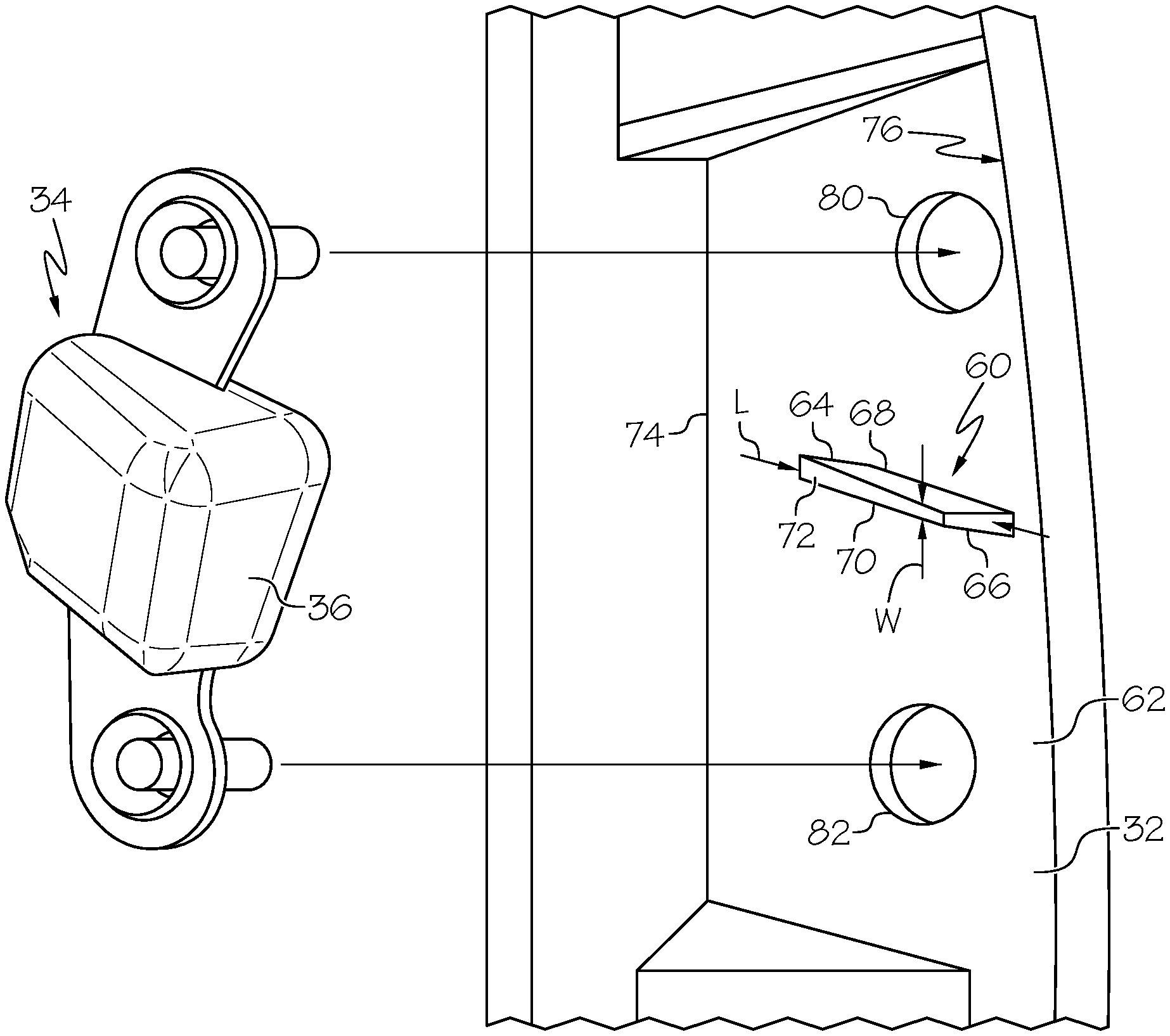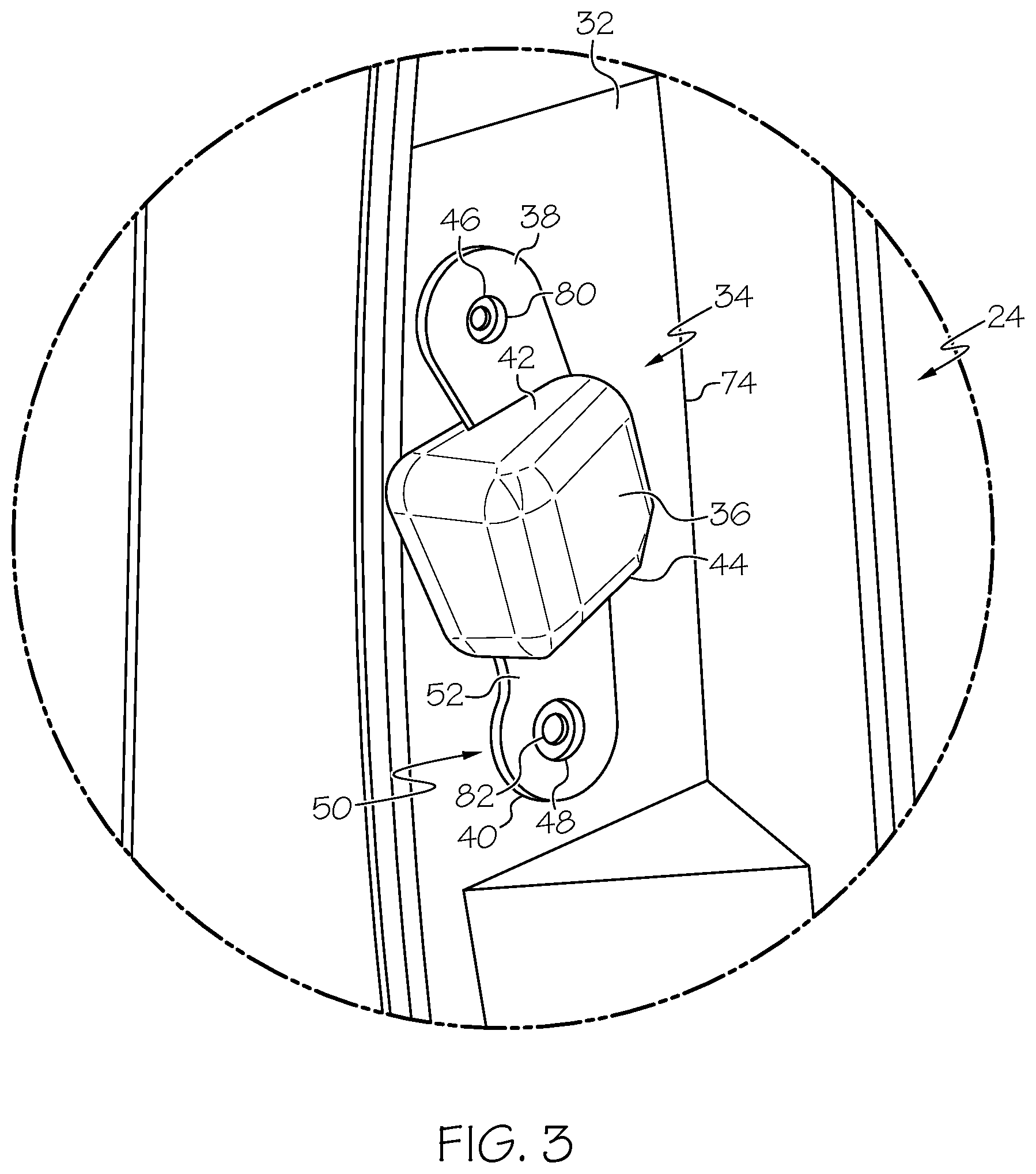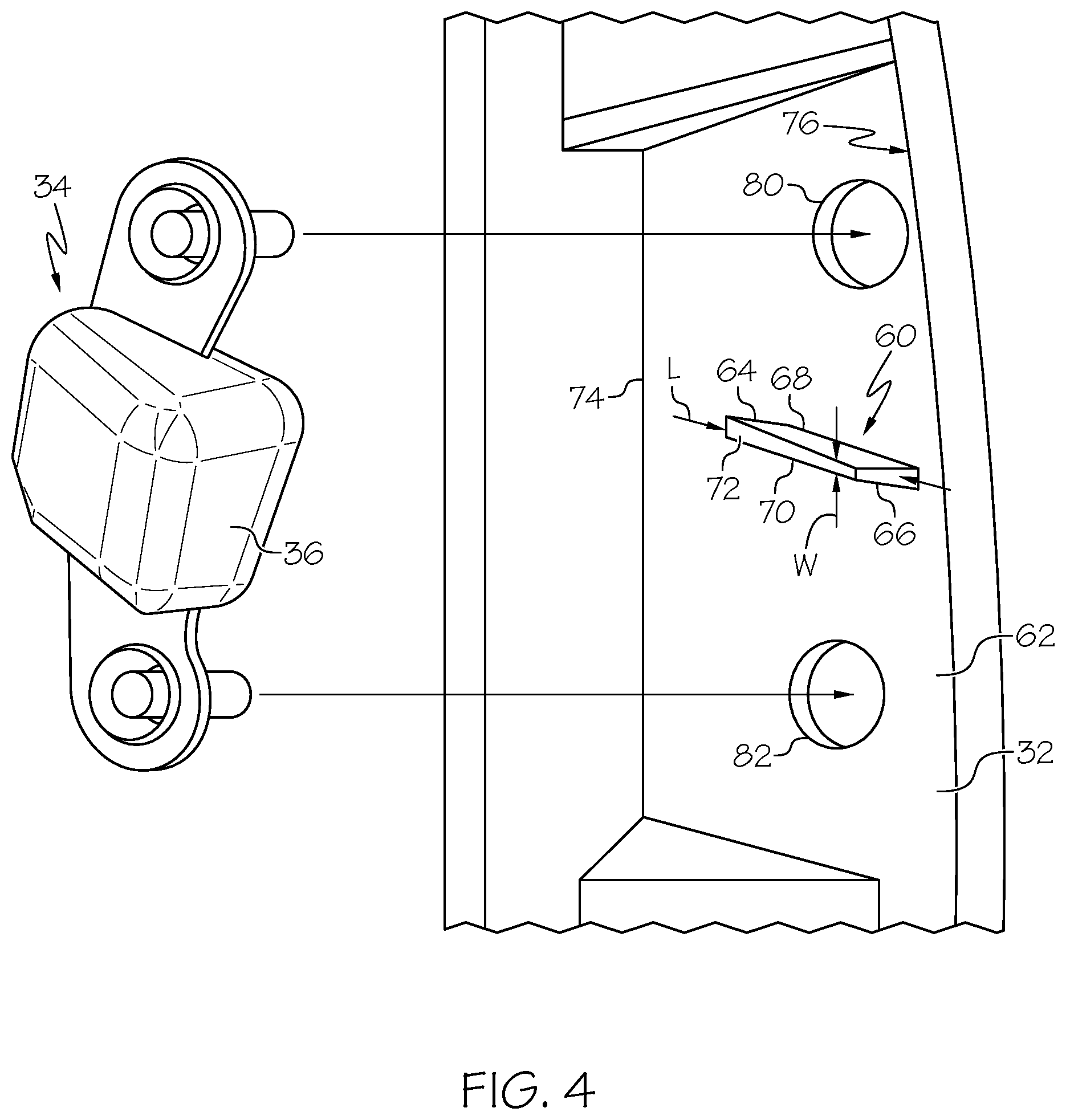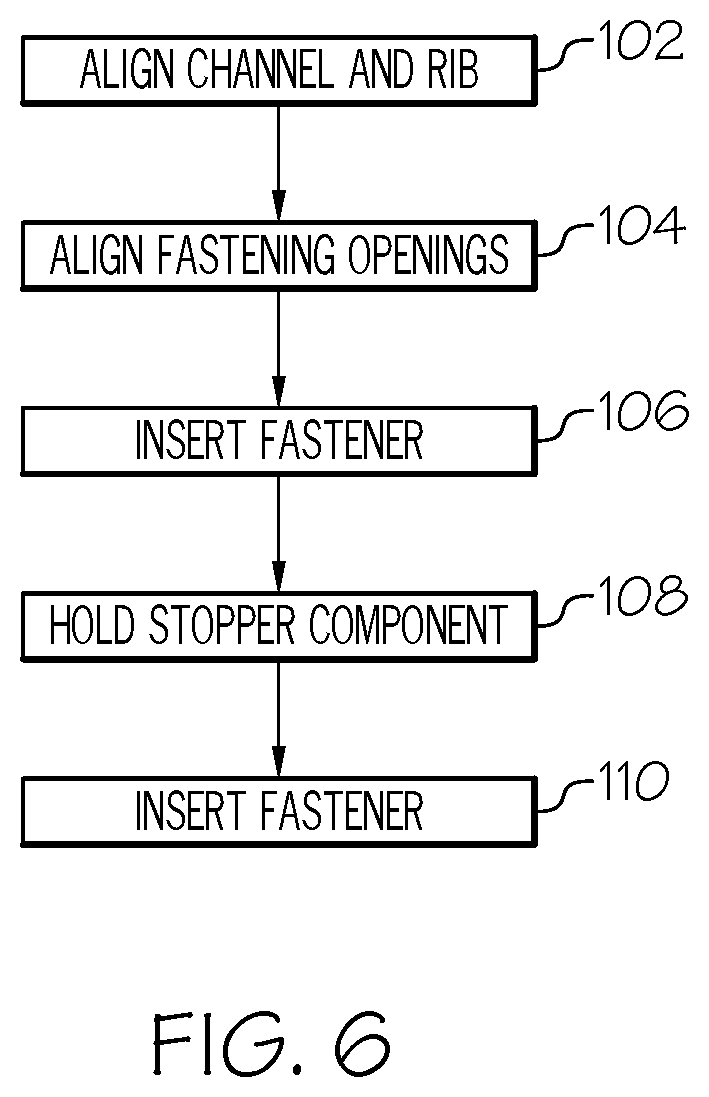Vehicle components including rib receiving channels for receiving alignment ribs of vehicle panels
Thurgate , et al. November 17, 2
U.S. patent number 10,836,238 [Application Number 16/240,170] was granted by the patent office on 2020-11-17 for vehicle components including rib receiving channels for receiving alignment ribs of vehicle panels. This patent grant is currently assigned to Toyota Motor Engineering & Manufacturing North America, Inc.. The grantee listed for this patent is Toyota Motor Engineering & Manufacturing North America, Inc.. Invention is credited to William Hardy, Kevin O'Beirne, Brian T. Thurgate.







| United States Patent | 10,836,238 |
| Thurgate , et al. | November 17, 2020 |
Vehicle components including rib receiving channels for receiving alignment ribs of vehicle panels
Abstract
A method of installing a vehicle component to a vehicle panel is provided. The method includes aligning a rib receiving channel of the vehicle component with an alignment rib that is formed integrally with the vehicle panel while also aligning a fastening opening of the vehicle component with a fastening opening through the vehicle panel. The alignment rib is inserted into the rib receiving channel. A fastener is inserted through the fastening openings of the vehicle component and the vehicle panel. The fastener is tightened while the alignment rib and rib receiving channel inhibit rotation of the vehicle component.
| Inventors: | Thurgate; Brian T. (Ypsilanti, MI), Hardy; William (Tecumseh, MI), O'Beirne; Kevin (Northville, MI) | ||||||||||
|---|---|---|---|---|---|---|---|---|---|---|---|
| Applicant: |
|
||||||||||
| Assignee: | Toyota Motor Engineering &
Manufacturing North America, Inc. (Plano, TX) |
||||||||||
| Family ID: | 71403862 | ||||||||||
| Appl. No.: | 16/240,170 | ||||||||||
| Filed: | January 4, 2019 |
Prior Publication Data
| Document Identifier | Publication Date | |
|---|---|---|
| US 20200215884 A1 | Jul 9, 2020 | |
| Current U.S. Class: | 1/1 |
| Current CPC Class: | B60J 5/0463 (20130101); B62D 65/06 (20130101); E05F 5/025 (20130101); B60J 5/107 (20130101); B62D 65/024 (20130101); E05F 5/022 (20130101); B60J 5/0468 (20130101); E05Y 2800/40 (20130101); E05Y 2600/56 (20130101); E05Y 2600/00 (20130101); E05Y 2900/546 (20130101) |
| Current International Class: | B60J 5/04 (20060101); B60J 5/10 (20060101); B62D 65/06 (20060101); E05F 5/02 (20060101) |
| Field of Search: | ;296/207 |
References Cited [Referenced By]
U.S. Patent Documents
| 1729231 | September 1929 | Toncray |
| 4432575 | February 1984 | Garvey |
| 5421124 | June 1995 | Zuccaro |
| 7014258 | March 2006 | Schubring |
| 7308731 | December 2007 | Schubring |
| 3010116 | Mar 2015 | FR | |||
| WO2010010262 | Jan 2010 | WO | |||
| WO2013093265 | Jun 2013 | WO | |||
Attorney, Agent or Firm: Dinsmore & Shohl LLP
Claims
What is claimed is:
1. A method of installing a stopper component to a shut face panel of a vehicle, the method comprising: aligning a rib receiving notch of the stopper component with an alignment rib that is formed integrally with the shut face panel while also aligning a fastening opening of the stopper component with a fastening opening through the shut face panel; inserting the alignment rib into the rib receiving channel; inserting a fastener through the fastening openings of the stopper component and the shut face panel; and tightening the fastener while the alignment rib and rib receiving notch inhibit rotation of the stopper component.
2. The method of claim 1, wherein the stopper component has a first flange and a second flange, the first and second flanges providing fastening locations located at opposite sides of a stopper body.
3. The method of claim 2, wherein the fastening opening through the shut face panel is a first fastening opening through the shut face panel and the fastening opening of the stopper component is a first fastening opening through the first flange, the method further comprising aligning a second fastening opening through the second flange with a second fastening opening through the shut face panel.
4. The method of claim 3 further comprising: inserting another fastener through the second fastening openings of the second flange and the shut face panel; and tightening the fastener while the alignment rib inhibits rotation of the stopper component.
5. The method of claim 4, wherein the stopper component comprising the stopper body and a bracket that is connected to the stopper body, the stopper body and the bracket formed of different materials, the bracket comprising the first and second flanges.
6. The method of claim 2, wherein the stopper body comprises: a pair of side walls; a pair of end walls that extend between the pair of side walls; and a support wall that extends between the side walls, the rib receiving notch comprising a notch formed in the support wall.
7. The method of claim 6, wherein the support wall is a first support wall, the stopper body comprising a second support wall that extends between the side walls, the rib receiving notch comprising a notch formed in the first support wall and the second support wall.
8. The method of claim 1, wherein the stopper component having a flange that provides a fastening location.
9. A vehicle comprising: a vehicle door assembly comprising: an outer panel; an inner panel connected to the outer panel; a shut face panel that spans a gap between the outer panel and the inner panel, the shut face panel comprising an alignment rib that is formed integrally with the shut face panel; a stopper component that is mounted to the shut face panel using a fastening opening that extends through the shut face panel, the stopper component comprising a fastening opening that is aligned with the fastening opening of the shut face panel, the stopper component comprising a rib receiving notch receiving the alignment rib.
10. The vehicle of claim 9, wherein the stopper component has a first flange and a second flange, the first and second flanges providing fastening locations located at opposite sides of a stopper body.
11. The vehicle of claim 10, wherein the fastening opening through the shut face panel is a first fastening opening through the shut face panel and the fastening opening of the stopper component is a first fastening opening through the first flange, the second flange comprising a second fastening opening aligned with a second fastening opening of the shut face panel.
12. The vehicle of claim 11, wherein the stopper component comprises the stopper body and a bracket that is connected to the stopper body, the stopper body and the bracket formed of different materials, the bracket comprising the first and second flanges.
13. The vehicle of claim 12, wherein the stopper body comprises: a pair of side walls; a pair of end walls that extend between the pair of side walls; and a support wall that extends between the side walls, the rib receiving notch comprising a notch formed in the support wall.
14. The vehicle of claim 13, wherein the support wall is a first support wall, the stopper body comprising a second support wall that extends between the side walls, the rib receiving notch comprising a notch formed in the first support wall and the second support wall.
Description
TECHNICAL FIELD
The present specification generally relates to installation of vehicle components on vehicle panels, and more specifically, installation of vehicle components that include rib receiving channels for receiving alignment ribs of vehicle panels for inhibiting rotation of the vehicle components during an installation operation.
BACKGROUND
Vehicles have a number of components that are attached to vehicle panels during assembly of the vehicles. For example, brackets may be connected to a shut face panel of a vehicle door assembly. These brackets may be used to align the vehicle door assemblies as the vehicle door assemblies are moved from an open position to a closed position. Installation of these brackets can be somewhat cumbersome, particularly for brackets that have multiple fastening locations. In some installation operations, for example, the installer may loosely tighten one fastener at one installation location, leave that installation location and move to a next installation location to tighten another fastener, only to return to the first fastener to complete tightening. The first fastening location is left loose so that the second fastening location can be aligned to the desired location of the shut face panel.
Accordingly, a need exists for vehicle components that include rib receiving channels for receiving alignment ribs of vehicle panels for inhibiting rotation of the vehicle components during an installation operation.
SUMMARY
In one embodiment, a method of installing a vehicle component to a vehicle panel is provided. The method includes aligning a rib receiving channel of the vehicle component with an alignment rib that is formed integrally with the vehicle panel while also aligning a fastening opening of the vehicle component with a fastening opening through the vehicle panel. The alignment rib is inserted into the rib receiving channel. A fastener is inserted through the fastening openings of the vehicle component and the vehicle panel. The fastener is tightened while the alignment rib and rib receiving channel inhibit rotation of the vehicle component.
In another embodiment, a vehicle includes a vehicle door assembly including an outer panel and an inner panel connected to the outer panel. A shut face panel spans a gap between the outer panel and the inner panel. The shut face panel includes an alignment rib that is formed integrally with the shut face panel. A stopper component is mounted to the shut face panel using a fastening opening that extends through the shut face panel. The stopper component includes a fastening opening that is aligned with the fastening opening of the shut face panel. The stopper component comprising a rib receiving channel receiving the alignment rib.
These and additional features provided by the embodiments described herein will be more fully understood in view of the following detailed description, in conjunction with the drawings.
BRIEF DESCRIPTION OF THE DRAWINGS
The embodiments set forth in the drawings are illustrative and exemplary in nature and not intended to limit the subject matter defined by the claims. The following detailed description of the illustrative embodiments can be understood when read in conjunction with the following drawings, where like structure is indicated with like reference numerals and in which:
FIG. 1 schematically depicts a perspective view of a vehicle including a vehicle door assembly, according to one or more embodiments shown or described herein;
FIG. 2 schematically depicts a more detailed view of the vehicle door assembly of FIG. 1 including a shut face panel with an alignment rib and a stopper component, according to one or more embodiments shown and described herein;
FIG. 3 schematically depicts an even more detailed view of the vehicle door assembly of FIG. 2 including the shut face panel with alignment rib and stopper component, according to one or more embodiments shown and described herein;
FIG. 4 illustrates the stopper component of FIG. 3 removed from the shut face panel to show the alignment rib, according to one or more embodiments shown and described herein;
FIG. 5 illustrates a rear view of the stopper component of FIG. 3 illustrating a rib receiving channel, according to one or more embodiments shown and described herein; and
FIG. 6 illustrates a method of installing the stopper component of FIG. 3 using the alignment rib and the rib receiving channel, according to one or more embodiments shown and described herein.
DETAILED DESCRIPTION
Vehicles according to the present specification include vehicle panels that include integrally formed alignment ribs that inhibit rotation of vehicle components when fastened to the vehicle panels. The alignment ribs may be formed of material that forms the vehicle panel, such as by integrally molding the alignment ribs during formation of the vehicle panels. The alignment ribs can be formed to be received within rib receiving channels that are provided within the vehicle components. The rib receiving channels may be provided on a panel facing side of the vehicle components. The rib receiving channels and the alignment ribs can be used to inhibit rotation of the vehicle components during fastening of the vehicle components to the vehicle panels. The rib receiving channels and the alignment ribs can also be used to align the vehicle components in a desired orientation during the installation operation and reduce a number of steps needed to complete installation of the vehicle components.
As used herein, the term "vehicle longitudinal direction" refers to the forward-rearward direction of the vehicle (i.e., in the +/-vehicle X-direction depicted in FIG. 1). The term "vehicle lateral direction" refers to the cross-vehicle direction (i.e., in the +/- vehicle Y-direction depicted in FIG. 1), and is transverse to the vehicle longitudinal direction. The term "vehicle vertical direction" refers to the upward-downward direction of the vehicle (i.e., in the +/- vehicle Z-direction depicted in FIG. 1). Further, the terms "inboard," "inward," "outboard" and "outward" are used to describe the relative positioning of various components of the vehicle. Because the vehicle structures may be generally symmetrical about the vehicle centerline, the direction to which use of terms "inboard," "inward," "outboard" and "outward" refer may be mirrored about the vehicle centerline when evaluating components positioned along opposite sides of the vehicle 10.
The vehicle 10 includes a vehicle body 12 including a body framework and having a front 16, a rear 18 and sides 20 that extend between the front 16 and the rear 18. The vehicle 10 includes a rear end assembly 22 at the rear 18 of the vehicle body 12. The rear end assembly 22 includes a vehicle door assembly 24 that is rotatably connected to the vehicle body 12 using hinges 26.
Motor vehicles that incorporate elements according to the present disclosure may include a variety of construction methodologies that are conventionally known, including a unibody construction methodology as well as a body-on-frame construction methodology. Furthermore, the Figures may only show one side of the vehicle. Descriptions of the other side of the vehicle may be omitted because both sides of the vehicle may be laterally symmetrical and substantially the same.
Referring also to FIG. 2, the vehicle door assembly 24 includes an outer panel 28 and an inner panel 30 that is spaced from the outer panel 28 in the vehicle longitudinal direction with the vehicle door assembly 24 in a closed position. A shut face panel 32 extends between the outer panel 28 and the inner panel 30 at a side 34 of the vehicle door assembly 24. The shut face panel 32 may be a monolithic and integrally formed part of the inner panel 30 and may be formed of a plastic material, such as by molding the shut face panel 32.
Referring to FIG. 3, a stopper component 34 includes a stopper body 36 and flanges 38 and 40 that extend outward from the stopper body 36 at opposite sides 42 and 44. In some embodiments, the stopper body 36 may be formed of an elastic material, such as a plastic or rubber. The flanges 38 and 40 may be formed of a different material, such as a metal and have fastening openings 46 and 48 extending therethrough to provide fastening locations where the stopper component 34 can be fastened to the shut face panel 32. In some embodiments, the flanges 38 and 40 are provided by a bracket 50 having a somewhat curved body 52 onto which the stopper body 36 is provided. For example, the stopper body 36 may be overmolded onto the curved body 52. In other embodiments, the stopper body 36 may be adhered onto the curved body 52. As can be seen the stopper body 36 provides the stopper component 34 with an increased thickness that mates with a corresponding stopper component 54 located on a shut face panel 56 of the vehicle body 12 (FIG. 1). The stopper body 36 provides alignment of the vehicle door assembly 24 as it returns to a closed position, while also providing damping to reduce shock as the vehicle door assembly 24 closes against the vehicle body 12.
Referring to FIG. 4, an alignment rib 60 is provided on the shut face panel 32. In particular, the alignment rib 60 is integrally formed with the shut face panel 32 such that the alignment rib 60 extends outwardly from a surface 62 of the shut face panel 32 in the vehicle lateral direction. In the illustrated embodiment, the alignment rib 60 is box-shaped having opposite ends 64 and 66, sides 68 and 70 and a face 72 that extends between the opposite ends 64 and 66. While the alignment rib 60 is illustrated as being box-shaped, the alignment rib may have other profiles, such as rounded. Further, the alignment rib 60 is illustrated as having a length L that is of a greater dimension than a width W of the alignment rib 60 providing an elongated shape that extends between edges 74 and 76 of the shut face panel 32. In some embodiments, the alignment rib 60 could be formed with a connector feature that can be used to connect other components, such as cross rib.
Referring to FIG. 5, the stopper component 34 includes the stopper body 36 having an outboard side 75 facing away from the shut face panel 32 and an inboard side 77 that faces toward the shut face panel 32. In the example of FIG. 5, the stopper body 36 is generally hollow and includes side walls 84 and 86 and end walls 88 and 90. Support walls 92 and 94 extend between the side walls 84 and 86 and are located within the stopper body 36. Each support wall 92 and 94 includes a respective notch 96 and 98 forming a rib receiving channel 100. While multiple notches 96 and 98 are illustrated, a single, elongated notch may form the rib receiving channel. The rib receiving channel 100 is sized and arranged to receive the alignment rib 60 in both the notches 96 and 98 and orients the stopper component 34 including the fastening openings 46 and 48 with fastening openings 80 and 82 (FIG. 4). The sectional shape of the notches 96 and 98 can correspond to the sectional shape of the alignment rib 60. In other embodiments, the sectional shape of the notches may be different than the sectional shape of the alignment rib. In some embodiments, the stopper body 36 may be formed from a single piece of material, such as by molding, and the notches may be formed during that process or by a different process such as by machining the notches 96 and 98 into the support walls 92 and 94.
Referring to FIG. 6, during an installation operation, the rib receiving channel 100 is aligned with the alignment rib 60 such that the notches 96 and 98 receive the alignment rib 60 at step 102. By aligning the rib receiving channel 100 with the alignment rib 60, the fastening openings 46 and 48 of the flanges 38 and 40 are also aligned with fastening openings 80 and 82 formed through the shut face panel 32 at step 104. A first fastener may be inserted through the fastening openings 46 and 80 at step 106. At step 108, the orientation of the stopper component 34 is supported by the alignment rib 60 as the first fastener is completely tightened. A second fastener may then be inserted through the fastening openings 48 and 82 at step 110 and completely tightened thereby installing the stopper component 34 to the shut face panel 32.
The above-described vehicle panels with integrally formed alignment ribs can provide a datum location for positioning of a vehicle component as the vehicle component is being installed to the vehicle panels. The alignment ribs may be formed as a monolithic part of the vehicle panels, which can little cost and mass to the vehicle panels. In some embodiments, the alignment ribs have a thickness that is substantially the same as the surrounding vehicle panel thickness (i.e., the alignment rib may be hollow), which can provide the reduced mass compared to a solid alignment rib. The vehicle component receives the alignment rib within a rib receiving channel so that the alignment rib inhibits rotation of the vehicle component as a fastener is being tightened. The alignment rib and rib receiving channel can reduce a number of steps to install the vehicle component, particularly when there is multiple fastening locations. While two fastening openings are illustrated, there may be only one fastening opening.
It is noted that the terms "substantially" and "about" may be utilized herein to represent the inherent degree of uncertainty that may be attributed to any quantitative comparison, value, measurement, or other representation. These terms are also utilized herein to represent the degree by which a quantitative representation may vary from a stated reference without resulting in a change in the basic function of the subject matter at issue.
While particular embodiments have been illustrated and described herein, it should be understood that various other changes and modifications may be made without departing from the spirit and scope of the claimed subject matter. Moreover, although various aspects of the claimed subject matter have been described herein, such aspects need not be utilized in combination. It is therefore intended that the appended claims cover all such changes and modifications that are within the scope of the claimed subject matter.
* * * * *
D00000

D00001

D00002

D00003

D00004

D00005

D00006

XML
uspto.report is an independent third-party trademark research tool that is not affiliated, endorsed, or sponsored by the United States Patent and Trademark Office (USPTO) or any other governmental organization. The information provided by uspto.report is based on publicly available data at the time of writing and is intended for informational purposes only.
While we strive to provide accurate and up-to-date information, we do not guarantee the accuracy, completeness, reliability, or suitability of the information displayed on this site. The use of this site is at your own risk. Any reliance you place on such information is therefore strictly at your own risk.
All official trademark data, including owner information, should be verified by visiting the official USPTO website at www.uspto.gov. This site is not intended to replace professional legal advice and should not be used as a substitute for consulting with a legal professional who is knowledgeable about trademark law.